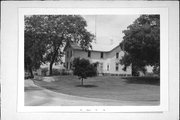Property Record
W SIDE OF COUNTY HIGHWAY Z .7 MI S OF COUNTY HIGHWAY H
Architecture and History Inventory
| Historic Name: | CARL HOLZ FARM |
|---|---|
| Other Name: | MAPLE SHADE FARM |
| Contributing: | |
| Reference Number: | 15032 |
| Location (Address): | W SIDE OF COUNTY HIGHWAY Z .7 MI S OF COUNTY HIGHWAY H |
|---|---|
| County: | Dodge |
| City: | |
| Township/Village: | Leroy |
| Unincorporated Community: | |
| Town: | 13 |
| Range: | 16 |
| Direction: | E |
| Section: | 20 |
| Quarter Section: | SE |
| Quarter/Quarter Section: | NE |
| Year Built: | 1883 |
|---|---|
| Additions: | |
| Survey Date: | 1974 |
| Historic Use: | house |
| Architectural Style: | Cross Gabled |
| Structural System: | |
| Wall Material: | Brick |
| Architect: | |
| Other Buildings On Site: | |
| Demolished?: | No |
| Demolished Date: |
| National/State Register Listing Name: | Not listed |
|---|---|
| National Register Listing Date: | |
| State Register Listing Date: |
| Additional Information: | A 'site file' exists for this property. It contains additional information such as correspondence, newspaper clippings, or historical information. It is a public record and may be viewed in person at the Wisconsin Historical Society, State Historic Preservation Office. In the 1850s, Carl and Louisa Holz emigrated from Prussia to this farm in Dodge County, where they probably grew wheat. From the 1850s through the 1870s, Dodge County helped make Wisconsin and the Midwest the nation’s breadbasket. When the Holzes first arrived, they could afford only a 29-acre farm, but by 1890, they owned nearly 320 acres. In 1876, they built this handsome front-gabled horse barn, a symbol of their increasing prosperity. Its formal architectural pretensions are unusual. The family even set a date marker, rarely found on barns, into the front gable, a clear expression of their pride. The now-unknown builder divided the gabled facade into three bays, with the center bay made of darker stones. Thin stone quoins separate the bays, giving the facade a striking sense of formality. Quoins also frame the windows and doors, segmentally arched on the ground floor and round-arched in the loft. By contrast, the builder used less-costly random-coursed rubble in a heavy mortar matrix for the less-visible side walls. The loft windows allowed Holz to pitch hay directly into the stable yard. The gabled cupolas on the roof ridge ventilated the loft to prevent the hay from heating and bursting into flame. Other farmstead buildings include a large Gothic-roofed Wisconsin Dairy Barn and a two-story brick farmhouse. The house was built in 1883 to replace a log structure. Like many farmers in the United States, Holz built a gabled ell, with few stylistic references. The sharp contrast between this simple house and the more ostentatious horse barn hint at Holz's priorities. MOULDED BRICK SEGMENTAL ARCH STILTED LINTELSSEGMENTAL ARCH FOUNDATION WINDOWS W/DECRATIVE BRICK SURROUNDS |
|---|---|
| Bibliographic References: | Buildings of Wisconsin manuscript. |
| Wisconsin Architecture and History Inventory, State Historic Preservation Office, Wisconsin Historical Society, Madison, Wisconsin |


